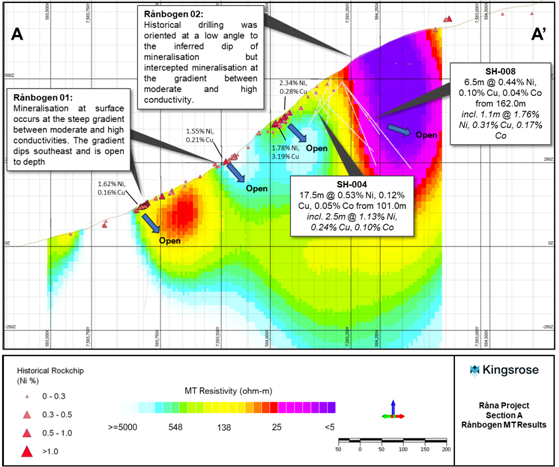Metals One (MET1) , a battery metals explorer with projects in Northern Europe, reported positive survey results from its nickel/copper/cobalt Råna Project in Norway.
The company said its partner and operator on the project, Kingsrose Mining, had analysed Spartan MT geophysical surveys at Råna's Rånbogen prospect, revealing 4 highly prospective zones for massive sulphide nickel-copper-cobalt mineralisation.
The Spartan MT surveys identified areas of low resistivity/high conductivity, representing 4 potential nickel-copper-cobalt sulphide zones at the Rånbogen prospect over a strike length of 1.8km. Three of the anomalies (Rånbogen 01, 02 and 04) were hosted within pyroxenite and peridotite lithologies of the Råna intrusion (see map below).
Meanwhile, Rånbogen 03 was a steeply south dipping, very strong conductor, located at the basal contact between the intrusion and footwall gneiss, which is known to contain conductive graphitic rock units. The location at the base of the intrusion is also a highly prospective setting for the accumulation of massive sulphides.

Where the conductive anomalies extended to surface, they displayed a strong correlation with massive and disseminated nickel-copper sulphide mineralisation identified in historical rock chip sampling. Target Rånbogen 02 in particular correlated well with historical drilling, which returned a best intercept of 17.5m at 0.53% Ni, 0.12% Cu, and 0.05% Co from 101m (SH004), including 2.5m at 1.13% Ni, 0.24% Cu, and 0.10% Co.
Looking ahead, ground-based and downhole electromagnetic surveys to aid detailed drill targeting are in progress at Rånbogen. Metals One's drill rig will be switched to a helicopter portable system in early August and transferred from the Bruvann Mine area to Rånbogen to test the conductive targets.
View from Vox
For those not versed in mining terminology, suffice it to say these are highly positive results from Metals One. The Spartan MT geophysical survey identifed strongly conductive (and therefore highly prospective) zones of massive nickel-copper-cobalt deposits, particularly nickel. The three metals are main ingredients in most Li-Ion battery chemistries, demand for which continues to climb amid increasing orders for EVs and grid storage solutions.
The Rånbogen prospect is only one of 3 priority prospects at Metals One's Råna project in Norway. Geophysical surveys not previously conducted in the area have suggested that the project will be highly profitable, though future EM surveys will further specify drilling targets to paint a fuller picture of project's potential. As Metals One transfers its rig to Rånbogen to test the prospective targets, investors should stay tuned and the company for more results from Råna.
On 31 July 2023, Metals One successfully listed on AIM. Admission followed a placing and subscription for a total of 44m shares at 5p, raising £2.2m. Metals One's European brownfield battery metals projects in Norway and Finland with approximately £9m of exploration carry exposure through farm-in agreements. The projects are either adjacent or analogous to other high-purity nickel sulphate deposits, and well connected to Europe's major electric vehicle OEMs and battery manufacturers.
Battery metals are key in the decarbonisation of transportation and the electrical grid. Europe is leading the way in EV adoption with 2.5m new EVs registered in 2022 alone, while OEMs are exploring opportunities to secure a sustainable supply of battery metals from ethically mined sources. In its 2023 Critical Raw Materials Act, the EU set targets to mine at least 10% of its critical raw materials by 2030, including for the first time nickel and copper.
Globally, battery metals will be needed at scales far beyond current supply, which is driving up their value. It is estimated that nickel demand from the EV sector in the EU alone will increase 30x from 17,000 tonnes in 2020 to 550,000 tonnes in 2040. With current domestic supply, the EU can only meet this demand until 2025 before a structural deficit emerges.
Follow News & Updates from Metals One:

